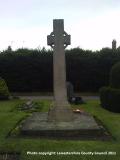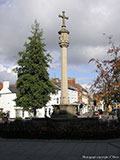Shipwright 1st Class Alexander Carnegie, 343178
- Batt -
- Unit - Royal Navy
- Section - HMS Pathfinder
- Date of Birth - 28/03/1880
- Died - 05/09/1914
- Age - 34
Add to this record?
If you have photographs, documents or information that can contribute to this record, you can upload here
ContributeSource: Michael Doyle Their Name Liveth For Evermore: The Great War Roll of Honour for Leicestershire and Rutland. He was the son of Alexander Carnegie a carpenter, born 1856 in Scotland and his wife Frances Mary Carnegie (nee Warner, married in the 4th quarter of 1871 in the Market Harborough, Leicestershire district), born 1847 in Glooston, Leicestershire. Alexander was born in the 2nd quarter of 1880 in Kibworth Beauchamp, Leicestershire, his siblings were, Elizabeth Frances, born 1872 in Market Harborough, Leicestershire, Margaret Annie, born 1874, James, born 1877 and Cecil Rawlins, born 1879, the latter three siblings were all born in Kibworth Beauchamp, in April 1881 the family home was at Kibworth Beauchamp. In April 1891 Alexander was a schoolboy and was residing in the family home at Main Street, Stonton Wyville, Leicestershire, together with his father, a carpenter, his mother and siblings, Margaret, James, Cecil, Eveline, born 1882 and Colin Charles, born 1884, the latter two siblings were both born in Kibworth. In April 1911 Alexander was serving as a Leading Shipwright Artificer with the Royal Navy and was stationed aboard HMS Boadicea at Harwich, Essex. In the 4th quarter of 1907, Alexander married Nellie Watts in the Market Harborough, Leicestershire district. In April 1911 Nellie, born 1880 in Huntingdonshire was residing at 45, Northampton Road, Little Bowden, Northamptonshire, together with their daughter Veria, born 1909 in Sheerness, Kent, this being the family home of her parents Charles and Matilda Watts.
Alexander enlisted into the Royal Navy to serve a 12 year engagement on the 25th January 1900 and was allocated the service number 343178 in Chatham, Kent. His medical examination recorded that he was 5 foot 3½ inches in height, with brown hair and hazel eyes, his complexion was described as fresh, he gave his trade of calling as carpenter. On re-examination on the 25th January 1912 his height was recorded as 5 foot 5 inches, his hair colour as dark and his complexion was described as dark. His record of service began when he joined HMS Pembroke II as a Carpenter Craftsman on the 25/1/00 – 28/3/00. HMS Cossack, 29/3/00 – 27/10/01, when he was promoted to Shipwright. HMS Cossack, 28/10/01 – 8/8/02. HMS Pembroke II, 9/8/02 – 20/10/02. HMS Caledonia, 21/10/02 – 16/9/04. HMS Pembroke II, 17/9/04 – 2/1/05. HMS Resolution, 3/1/05 – 31/7/05. HMS Venerable, 1/8/05 – 18/8/05, when he was promoted to Leading Shipwright. HMS Venerable, 19/8/05 – 27/12/07. HMS Pembroke II, 28/12/07 – 14/1/08. HMS Wildfire, 15/1/08 – 30/6/08. HMS Pembroke II, 1/7/08 – 9/6/09. HMS Boadicea, 10/6/09 – 5/6/11. HMS Pembroke II, 6/6/11 – 17/8/11. HMS Amethyst, 18/8/11 – 30/11/12, when he was promoted to Shipwright 2nd Class. HMS Amethyst, 1/12/12 – 31/12/12, when he was promoted to Shipwright 1st Class. HMS Amethyst, 1/1/13 – 30/9/13. HMS Pathfinder, 1/10/13 – 5/9/14, when he was killed during an action with a submarine off the Firth of Forth, Scotland. The background relating to the circumstances in which Alexander lost his life are as follows; At the beginning of September 1914 Otto Hersing of U-21 ventured to the Firth of Forth, home to the major British naval base at Rosyth. Hersing is known to have penetrated the Firth of Forth as far as the Carlingnose Battery beneath the Forth Bridge. At one point the periscope was spotted and the battery opened fire but without success. Overnight Hersing withdrew from the Forth, patrolling the coast from the Isle of May southwards. From a distance, on the morning of 5th September he observed the SSE course of HMS Pathfinder followed by elements of the 8th Destroyer Flotilla. The destroyers altered course back towards the Isle of May at midday while HMS Pathfinder continued her patrol. Hersing spotted HMS Pathfinder on her return journey from periscope depth at 3.30 pm. This time he resolved to make an attack. At 3.43 pm Otto Hersing fired a single 20 inch Type G torpedo. 5th September was a sunny afternoon. At 3.45 pm lookouts spotted a torpedo wake heading towards the starboard bow at a range of 2,000 yards. The officer of the watch, Lieutenant Commander Favell attempted to take evasive action by ordering the starboard engine be put astern and the port engine at full ahead while the wheel was turned hard a port. Since the vessel was travelling at a mere five knots, however (due to a shortage of coal throughout the Royal Navy at the time), the manoeuvre was not in time and the torpedo struck the ship beneath the bridge at 3.50pm. The detonation apparently set off cordite bags in the forward magazine which caused a second, more massive explosion within the fore section of the ship, essentially destroying everything forward of the bridge. Broken in two, the "Pathfinder" instantly began sinking, dragging most of her crew down with her and leaving a massive pall of smoke to mark her grave. The vessel sank so quickly, in fact, there was insufficient time to launch lifeboats. (Indeed, the remains of a lifeboat davit and rope can still be seen on the wreck, demonstrating the speed with which the vessel sank). The forensic evidence of the wreck is that everything before the first funnel disintegrated. The majority of the crew below decks in the forward section had neither the time nor the opportunity to escape. Although the explosion was well within sight of land, Captain Martin-Peake knew it was essential to attract attention. He ordered the stern gun to be fired. The king-pin must have been fatally damaged by the explosion, because after firing a single round, the gun toppled off its mounting, rolled around the quarter deck, struck the after screen then careered over the stern, taking the gun crew with it. There was no list but there was insufficient time to lower boats. Indeed the remains of a lifeboat davit and rope can still be seen on the wreck. The propeller belonging to the ship’s boat lies on the deck nearby. Lt. Edward Oliver Sonnenschein (he changed his name to Stallybrass on 8th January 1918) recalled that the bulkheads held firm until five minutes after the big explosion. “The ship gave a heavy lurch forward and took an angle of about forty degrees down by the bow. Water came swirling up to the searchlight platform. The Captain said, “jump you devils jump !”. The Captain and his secretary remained with the ship until the very end but somehow both survived.” The bow section sheared off under the strain as the stern heaved up to a sixty degree angle. Then it quietly slipped below the surface. Eyemouth fishing boats were first on the scene and encountered a field of debris, fuel oil, clothing and body parts. Destroyers HMS Stag and HMS Express had spotted the smoke and headed for the pall of smoke. One of the destroyers had an engine problem when a water inlet was blocked by a leg in a sea boot. There is significant confusion regarding the numbers of survivors. On 6th September The Times declared that 58 men had been rescued but that four had died of injuries. The fact that it is impossible to determine how many were on board that day, adds to difficulties but research indicates that 268 personnel were on board plus two civilian canteen assistants. There were just eighteen known survivors. The St. Abbs’ lifeboat came in with the most appalling accounts of the scene. There was not a piece of wood, they said, big enough to float a man—and over acres the sea was covered with fragments—human and otherwise. They brought back a sailor’s cap with half a man’s head inside it. The explosion must have been frightful. It is thought to be a German submarine that did it, or, possibly, a torpedo fired from one of the refitted German trawlers, which cruise all round painted with British port letters and flying the British flag. Despite the events of 5th September having been easily visible from shore, the authorities attempted to cover up the sinking, and HMS Pathfinder was reported to have been mined. Admiralty came to an agreement with the Press Bureau which allowed for the censoring of all reports. The Scotsman however published an eye-witness account by an Eyemouth fisherman who had assisted in the rescue. The account confirmed rumours that a submarine had been responsible, rather than a mine. However The Scotsman also reported that HMS Pathfinder had been attacked by two U-boats and had accounted for the second one in her death throes. Admiralty intelligence later claimed that cruisers had cornered the U-boat responsible and shelled it to oblivion. The sinking of HMS Pathfinder by a submarine made both sides aware of the potential vulnerability of large ships to attack by submarines.
- Conflict - World War I
- Unit - Royal Navy
- Cause of death - KILLED IN ACTION
- Burial Commemoration - Chatham Naval Mem., Kent, England
- Born - Kibworth, Leicestershire
- Enlisted - 25/01/1900 In Chatham, Kent
- Place of Residence - 50 Bath Street, Market Harborough, Leicestershire, England
- Memorial - MARKET HARBOROUGH MEM., LEICS
- Memorial - ST. HUGH'S CHURCH, MARKET HARBOROUGH, LEICS
- Memorial - ST. NICHOLAS'S CHYRD. MEM., LITTLE BOWDEN, NORTHANTS
- Memorial - COTTAGE HOSPITAL WAR MEM., MARKET HARBOROUGH, LEICS
- Memorial - KIBWORTH GRAMMAR SCHOOL MEM., LEICS



